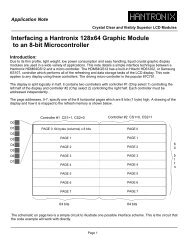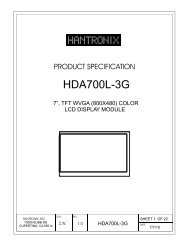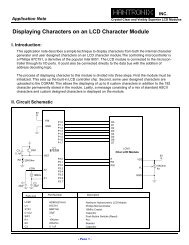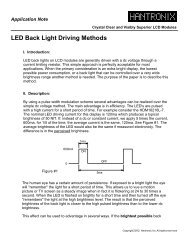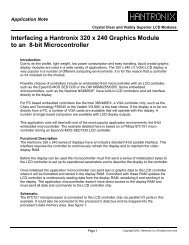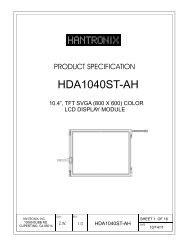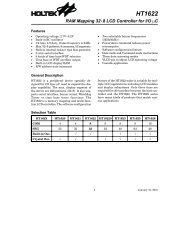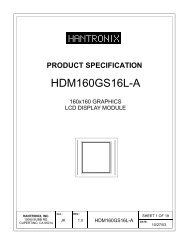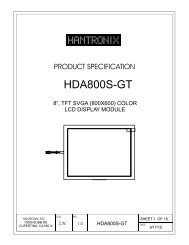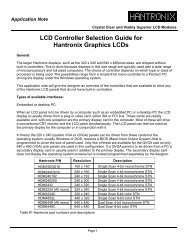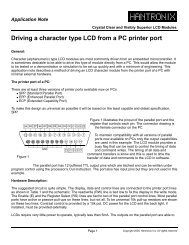Temperature Compensation for LCD displays
Temperature Compensation for LCD displays
Temperature Compensation for LCD displays
You also want an ePaper? Increase the reach of your titles
YUMPU automatically turns print PDFs into web optimized ePapers that Google loves.
Application Note<br />
CrystalClearandVisiblySuperior <strong>LCD</strong>Modules<br />
<strong>Temperature</strong> <strong>Compensation</strong> <strong>for</strong> <strong>LCD</strong> <strong>displays</strong><br />
The optimal contrast setting <strong>for</strong> <strong>LCD</strong> <strong>displays</strong> varies with ambient temperature. For most<br />
applications this variation in contrast is tolerable over the “normal” temperature range of 0°C to<br />
+50°C. Most Hantronix <strong>LCD</strong> modules are available with an extended temperature range option<br />
which allows the display to operate from -20°C to +70°C. The changes in contrast are NOT<br />
usually tolerable over this wide arange of temperatures, which means away of adjusting the<br />
contrast voltage as the ambient temperature changes must be provided.<br />
As the temperature decreases t he <strong>LCD</strong> fluid requires ahigher operating voltage in order to<br />
main tain agiven optical contrast. See figure #1. One way to provide <strong>for</strong> this is to give the user<br />
control of the contrast. This is asimple solution but quite often its not desirable or practical.<br />
+1<br />
R<br />
E<br />
L<br />
A<br />
T<br />
I<br />
V<br />
E<br />
V<br />
O<br />
L<br />
T<br />
A<br />
G<br />
E<br />
+0.5<br />
0<br />
-0.5<br />
-1<br />
CIRCUIT<br />
<strong>LCD</strong><br />
-25 0 +25 +50 +75<br />
TEMPERATURE (°C)<br />
Figure #1. <strong>Temperature</strong> compensated voltage provided by the circuit in Figure #2<br />
(solid line). The dashed line describes the way in which the <strong>LCD</strong> operating voltage<br />
varies with temperature.<br />
The chart can be used to predict the voltage at VL needed to produce good<br />
contrast on the display by adding the “relative voltage” to the contrast voltage of<br />
the display at 25°C. If, <strong>for</strong> instance, adisplay looks good with -3v on VL<br />
at room<br />
temperature (25°C) this display will need -2.7v at 50°C.<br />
-Page 1-
CrystalClearandVisiblySuperior <strong>LCD</strong>Modules<br />
The controlling microprocessor could measure the ambient temperature and supply the<br />
proper voltage to the <strong>LCD</strong>, but this is complicated and expensive.<br />
The most common solution to the temperature compensation problem is to provide acircuit<br />
such as that in Figure #2 to adjust the contrast voltage automatically.<br />
+5v<br />
15K @25°C<br />
B=4200(k)<br />
T<br />
510k<br />
8.2k<br />
<strong>LCD</strong> V L<br />
2N4402<br />
V EE<br />
3.9k<br />
Figure #2. Schematic diagram, simple compensation circuit.<br />
This circuit uses anegative temperature coefficient thermistor to sense the ambient<br />
temperature. It should be placed as physically close to the <strong>LCD</strong> module as possible. The<br />
PNP transistor is connected as an emitter foll ower to provide the drive current to the <strong>LCD</strong>’s<br />
contrast voltage (V )input.<br />
L<br />
The voltage VEE will vary depending on the requirements of the <strong>LCD</strong>. NOTE: VL and VEE<br />
are<br />
measured in relation to the VDD<br />
supplied to the <strong>LCD</strong>. An extended temperature range<br />
character display will require about -7.8v at its VL<br />
input at 25°C or about -2.8v relative to<br />
ground. The VEE<br />
voltage will need to be about 25% higher than the actual voltage required at<br />
the VL<br />
input of the <strong>LCD</strong>. During development the VEE<br />
should be avariable voltage that can be<br />
used to adjust the contrast to an optimal level. The VEE<br />
can be made fixed or adjustable <strong>for</strong><br />
the production units.<br />
This circuit will work <strong>for</strong> all character modules and graphic modules up to 320 x240.<br />
Modules larger than this are not available with the extended temperature option.<br />
-Page 2-



